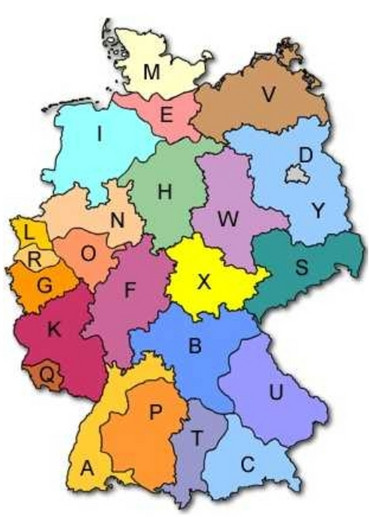Districts, DOKs and a mysterious multiplier

Germany extends over 630 km from East to West and over nearly 900 km from North to South. It is quite common that the more southern parts experience at least slightly better condx on Hf. Around 70 000 of Germany´s 82 million inhabitants are licenced hams. More than 40 000 of them are members of DARC. It has 24 districts with more than 1000 local chapters ("Ortsverbände"). Their abbreviation (DOK) consists of a letter for the district and a two digit number for the local chapter, like P03 Friedrichshafen (city of the "Hamradio" exhibition") or F41 Baunatal (location of the DARC-headquarter). Note: A zero in a DOK is a common trap often being logged as the letter O.
Districts & Federal states
M = Schleswig-Holstein
V = Mecklenburg-Vorpommern
E = Hamburg
I (some DOKs) = Bremen
H, I = Niedersachsen
W = Sachsen-Anhalt
Y = Brandenburg
D = Berlin
G, L, N, O, R = Nordrhein-Westfalen
F = Hessen
X = Thüringen
S = Sachsen
K = Rheinland-Pfalz
Q = Saarland
A, P = Baden-Württemberg
B, C, T, U = Bayern
DOKs with letter Z belong to the associated club VFDB of hams in telecommunications and post. Its DOKs are scattered over Germany and you may look here, where a certain Z-DOK is located.
If you want to start chasing DOKs here is a Excel-list with all of them and the five WAG-bands. But of course you can extend the chase beyond this weekend - there are so many of them. DOKs are the base for one of the major German awards, the DLD.
The strange 26th multiplier
According to the rules each district per band counts as a multiplier. So the regular DARC/VFDB districts allow for 25 multipliers per band. But you may have seen scores with 26 multipliers per band. The only letter which is not used for a disctrict name is J - regularly asked for in participants´ reports. But even if there is no J-district you can still work a J-multiplier:
That is because there are also special DOKs ("Sonder DOKs") which are granted for special occasions for a limited time, like the year of a city´s jubilee or for divisions of DARC. They can be quite a challenge to copy in a contest - think about highspeed CW exchanges with an unexpected DOK like "60CHILD" (if your logsoftware only accepts the first four letters it is ok for us if they are copied correctly). The rules say that their first letter, regardless of any figures preceding it, is used for multiplier purpose like a letter of a district. So if you work one of the rare stations with a special DOK containing J as the first actual letter, you have bagged the mysterious multiplier.
What does a German callsign tell?
The number in a German call says nothing about the geographic location, other than in many countries with callsign districts (a Zero after prefixes DF, DK and DL indicates a clubstation).
German hams can keep their callsign when moving. Therefore even the few geographic indications in calls can be misleading. In 2x3 calls with DL-prefix the first and second letter of the suffix give a hint where the callsign was issued indicating a wider area around where the holder may live. DL8MBS means that the call was issued in Munich, DL6MHW in Magdeburg, DL1SAA in Stuttgart in the southwest, DL1SZA in Schwerin in the northeast. There are even experts who know the regional origins of callsign blocks in 2x2 calls.
But better use the database of our licensing authority Bundesnetzagentur (BNA) shown below for looking up the actual address of a ham. You can copy&paste the street and city part of the result into googlemaps etc. to even see the location from above ;-)
Two prefixes indicate licence classes: Holders of DO calls are on HF restricted to 160, 80, 15 and 10m. DN are training calls that newcowers can use on those bands on which the licence holder is allowed to operate.
2x1 calls like DR2Q are contest/clubcalls that may be used by Single Ops or Multi Ops.
What you can NOT see from a German call is the DOK, because the DOK has nothing to do with licensing but with DARC-membership. German hams can change their DOK rather easily so it is very risky to depend in the contest on databases with calls and DOKs. We delete a big lot of QSOs each year because participants log what their databases say instead of what the German stations say or send on the air.













































